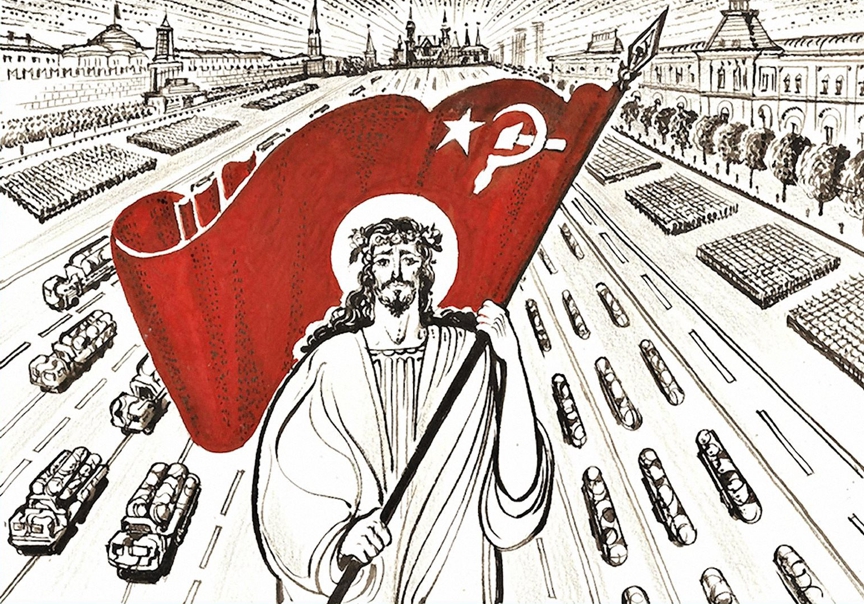Many people are surprised and others are alarmed that Russian Orthodoxy and Communism are so “easily interchangeable,” but Moscow blogger Yury Komarov says they shouldn’t be because the two share many features, the result of the Bolsheviks’ adaptation of Orthodox customs after 1917 to win over the population.
As a result, he says, “the format of both cults” is remarkably similar, even though one is atheistic and the other religious” because both “however paradoxical this may sound are both at the beginning and the continuation of each other.” And that means that a society which initially follows one can easily shift to the other later.
Komarov lists eight similarities between the two which allow individuals to move from one to the other with far less difficulty than many might expect:
- Both have saints, a large number of individuals who must be deferred to, a hierarchy of such people, and organizations that in each case are beyond question.
- Both promote a cult of martyrdom, of deep respect for those who died for their faith. Neither shows particular respect for the living, however; and both require continuing sacrifices because of their respective promises for good in some future time.
- Both enshrine this “metaphysical” quality in symbols such as the cross for the Orthodox and the five-pointed star for the communists.
- Both reject immediate material well-being. Each calls on its followers to sacrifice his immediate needs for the future of the ideology, even if the party leaders or the church hierarchs ignore and are known to ignore this principle.
- Both have to engage in a struggle with those who disagree and are inclined to totalitarianism. Any cult religious or civil that doesn’t defeat those who question it is doomed. And that in turn leads both of them to ever more radical tactics against their opponents. “In some cases, this is repression; in others, inquisition.”
- Both promote feelings of guilt and responsibility. The Orthodox Church “cultivates a sense of guilty forcing parishioners to consider themselves sinful” and in debt to Christ; the communists do the same with Lenin and the party.
- both promote a cult of those who have died, a direct result of the cult of martyrdom. Neither “ever cultivated one of the living but always was distinguished by fanaticism in respect for those who died for the motherland or for the faith./li>
- Both promote the idea that there are holy places that are sacred.
Thus “we see,” Komarov concludes, “that religion and communism have interchangeable formats” and people can thus move quickly from one to the other. And that explains something else: the communists had to try to root out religion precisely because it was so similar just as the Orthodox had tried to do with communism.
Thus, Orthodox Russians remarkably quickly became communist Soviets after 1917, and many communists, no less easily, “again adopted Orthodoxy immediately after the fall of the USSR.” For them, “the code of the builder of communism and Christian teachers are two variants of a single text.”
And as a result, they can “replace Lenin with Christ and Christ with Lenin -- without that having any terrible consequences in their consciousness.”
Related:
- Religious persecution continues in occupied Donbas
- Statement of heads of Evangelical Protestant Churches of Ukraine on religious persecution in the Donetsk and Luhansk Oblasts
- Scholar: Russian Orthodox Church Moscow Patriarchate supports repressions, militarism
- Chaplin, 'a Zhirinovsky from the Orthodox Church,' says mass repressions necessary and reasonable
- Authorities ready to demolish only Ukrainian church in Russia
- How Russia used Orthodox fundamentalism to hijack the Church Council in Crete
- How the Moscow Patriarchate is creating a separatist Lavra "Republic" in Kyiv
- Pro-Russia militants in occupied east Ukraine torture Protestant pastor to convert to Russian Orthodox Church
- The Kremlin turns priests into obedient "comrades"
- The Russian Orthodox Church of the Moscow Patriarchate resembles the CPSU of Soviet times
- Moscow Patriarchate beefs up its staff for hybrid operations against Ukraine

